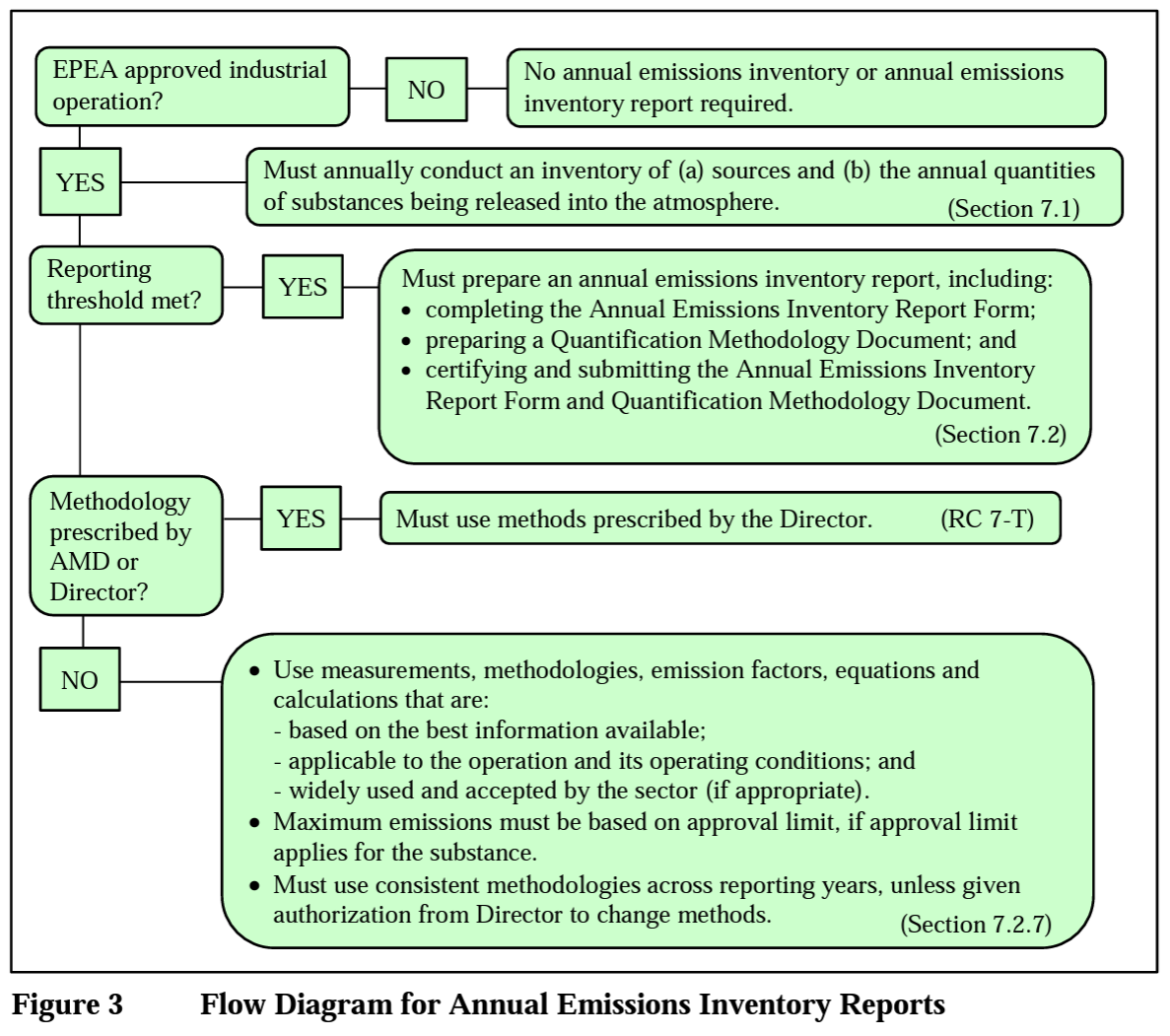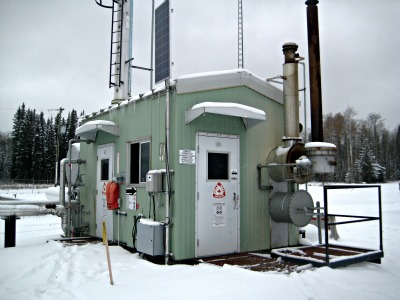- Air Homepage
- Alberta Air Quality
- Industrial Air Emissions
How to report industrial air emissions accurately and comply with regulations.
Make your way through industrial air emissions reporting in Alberta. Environmental Protection and Enhancement Act (EPEA) requirements, including Annual Emissions Inventory Reports (AEIR) and Air Monitoring Directives (AMD). See the whole document here.
The page gives you an overview emissions thresholds, quantification, non-point sources, deadlines, and methods covered in Chapter 9 of the AMD, Sections 7 to 11. See a summary of the first six sections on this page.
Reporting industrial air emissions - Section 7
The EPEA requires industrial operations to keep an annual list of the substances they release into the air. If certain criteria are met, they have to submit an AEIR.
If your approval requires production data reporting, you should use the AMD Production Form. If you haven't already, you might need to describe additional air monitoring and provide results. If you use sulfur blocks, give a summary. Any changes you made to your operation should be summarized.
Here's how AEIR works:
Air emissions, thresholds, and substances (RC 7-C): The responsible person must submit an AEIR if an industrial operation releases certain substances above certain threshold levels (8 substances listed in Table 1 of the document). The table shows what emission levels trigger the requirement to report emissions inventories.
Air emissions quantification (RC 7-D):
An annual emissions inventory report must quantify annual actual, normal, and maximum industrial air emissions at each air emission release point at the industrial operation for substances listed in Appendices B and C. These terms are defined in the document.
Non-Point Sources of Air Emissions (RC 7-E):
It's like RC 7-D, except for diffuse emissions from different sources, which are non-point sources of air pollution. Materials handling, mine faces, mine fleets, solid mine tailings, non-stationary equipment, fugitive leaks, road dust, space heating, storage tanks, and liquid tailings ponds are some examples.
Reporting deadline and form (RC 7-F to J):
By September 30, AEIRs have to be submitted to the Director. There's a form you have to fill out. This form shouldn't be modified except for entering the info. RC 7-K reports should include information about the company, the operation, the location, and contact info. You should also describe any operational incidents. (RC 7-L and -M) reports must include emissions, emission limits, and pollution control measures for each release point. RC 7-N and -O specify requirements for non-point sources, like storage tanks and piles.
This section (RC 7-P) must include extra information like changes from the previous year, plant changes, and measurement changes. In Methods (RC 7-Q to -U), you'll learn how to calculate industrial air emissions, including measurement equipment, estimation methods, and emission factors. For each industrial operation, the best data and methods are used.
The certification process is outlined in (RC 7-X and -Y). The responsible person must review and certify an accurate, complete, and diligently prepared report. AEIR problems (outlined in RC 7-Z to -GG) might need fixing:
The purpose of this part is to explain how to report errors and omissions in reports. Reports that need to be corrected or amended must follow specific guidelines. AEIR helps industrial operations report emissions data accurately and thoroughly so they can comply with environmental laws.
Sub-section 7.3 gives you a flowchart to figure out what you'll need in your AEIR. This is just a guide. Think of it as a checklist to make sure you have everything. It depends on the AMD Reporting Chapter, your industrial operation's approval, and any special instructions from the Director. Before you start writing, check those documents. Here's a copy for reference, but the full-resolution version on the AMD will be easier to read.
 AEIR reporting flowchart
AEIR reporting flowchartWe're here to help you every step of the way at Calvin Consulting Group Ltd. Make sure you're in compliance with environmental regulations with accurate air emissions reporting. Just send Barry a quick message at:
Get expert advice tailored to your needs from us.
Industrial Notifications - Section 8
When to tell the Director about certain industrial operations and monitoring:
- Samples are taken from industrial air emissions sources,
- operations are started or stopped, equipment is moved, and
- monitoring tools are changed.
You don't have to notify the Director if you're just monitoring air for your own purposes. However if you decide (or are required) to share monitoring data with the regulator, you should follow the AMD.
You have to give the Director at least 14 days' notice using the AMD Stack Survey and Relative Accuracy Test Audit (RATA) Notification Form when applicable. Tell us what you're testing, when, and how.
Unless the Director says otherwise, you need to let the Director know if your plans change ASAP. Explain why rescheduled surveys or audits are happening, like bad weather or equipment problems.
If you're setting up a new monitoring station, changing a parameter, or changing your monitoring method, use the AMD Notification Template. You also need to let the Director know 14 days in advance if you're doing continuous ambient monitoring for less than 12 months a year.
You should let the Director know at least 30 days before you shut down an ambient analyzer or meteorological sensor. A 30-day notice is also required when moving an ambient air monitoring station. Regulators might also have to approve these changes.
If you need to start or stop your operation, use the AMD Notification Template. As soon as you know the dates for these notifications have changed, fill the Director in.
Additional industrial monitoring - Section 9
Here's how to report manual stack surveys, RATAs, and Cylinder Gas Audits (CGAs). You have to submit your report by the end of the month following the survey. It's best if you can find a qualified testing company to conduct these surveys. After than a good consulting firm can help you analyze and interpret the data.
The Alberta Stack Sampling Code should be followed when conducting manual stack surveys (Sub-Section 9.1). After a manual stack survey, you need to write a report. Send the AMD Manual Stack Survey Summary Form to the Director.
It should include info like the source identifier, testing dates, pollutant info, and results. Unless the Director gives written instructions otherwise, reports and summary forms should be submitted by the end of the month after the survey.
Requirements for manual stack surveys (RC 9-A to -Y):
Reports must include all the information required by the Alberta Stack Sampling Code. Be sure to include a cover letter with details like approval number, source identifier, survey dates, and industrial process conditions. The title page should include the industrial operation, survey date, source identifier, and author.
Include a source identifier, stack height and diameter, testing dates, production rates, parameter list, sampling methods, analytical methods, and a summary of the results.
Describe your sampling and analysis methods, any deviations from approved methods, and any US EPA-approved instrument methods you used. Report any deviations from approved methods. Sampling should be done by an ISO/IEC 17025-certified lab.
Explain why you didn't meet approval limits, any problems you encountered, and any corrective measures you took. Add an appendix with detailed results, including source identification, sampling details, and test results.
Please provide computer output or equivalent data. Include drawings of the stack being tested, velocity profiles for each traverse, raw field data, survey calculations, lab accreditation details, laboratory analysis reports, and calibration certificates. To monitor and declare compliance with emission limits, industrial operations need these reports. Sections 9.2 and 9.3 describe how to report industrial emissions data, specifically RATA and CGA.
The RATA reports verify the accuracy of emissions monitoring systems. Manual stack surveys can also be done with RATA data. Manual stack sampling requires specific reporting guidelines for RATA results. Here's an example:
For one-hour compliance runs, you need two consecutive RATA runs. Every RATA conducted has to have a report summited, complete or not. Details like source identifiers, analyzer info, audit dates, and results should be in reports.
Compliance tests and parameter units are needed for manual stack surveys. The Director needs reports and summaries by a certain date.
A CGA is another way to test emissions monitoring systems. Just like RATA, every CGA has to submit a report to the Director.
Include the parameters monitored, analyzer details, gas concentrations, and audit results. You'll also need a cover letter with things like approval numbers, audit dates, and performance comparisons.
A title page and a table of contents are needed for reports with a lot of information (under RC 9-AAA). Unless otherwise authorized, both RATA and CGA reports must include all the necessary information. Performance specs, production rates, and variances are compared.
Reports should discuss non-compliance, calibration gases, and test results. As part of each test's appendices, you should have detailed results, computer output, and raw data, since accurate emissions monitoring and detailed reporting help ensure compliance. Reporting requirements are quite technical and the original document has a lot of details. The purpose of this page is just to give you an overview.
Section 10 - Industrial Supplemental Monitoring Results
For industrial operations, this part covers RATA and CGA rules.
Once again, RATA reports verify emissions monitoring systems' accuracy. Manual stack sampling can also be done using RATA data, but specific reporting guidelines must be followed. One-hour compliance runs require two consecutive RATA runs on the same day. Every RATA has to submit a report, no matter how incomplete it is. Source identifiers, analyzer info, audit dates, and results should all be included in reports.
Compliance tests and parameter units are needed for manual stack surveys. The Director needs reports and summaries by a certain date.
CGAs are another way to test industrial air emissions monitoring systems. Every CGA has to submit a report to the Director. Report the parameters monitored, analyzer details, gas concentrations used, and audit results. If the report is long, you'll also need a cover letter with info like approval numbers, audit dates, and performance comparisons.
Unless otherwise authorized, RATA and CGA reports must include all the info needed to comply with the Continuous Emissions Monitoring System (CEMS) Code. Performance specs, production rates, and variances need to be compared.
Non-compliance, calibration gases, and test results assessment should be discussed in reports. To ensure compliance, each test's appendices should include detailed results, computer output, raw data, and accurate emissions monitoring. Alternative procedures can also be used instead of CGA under certain conditions, with the same reporting requirements. Keep in touch with the director.
Section 11 - Amendments to Industrial Reports and Data
What to do if there's a mistake or missing data in air monitoring reports. Resubmitting the report to the regulatory director must be corrected right away if there are errors or problems. Describe what went wrong, why it happened, and how it was fixed.
Within 30 days of discovering the issue or being notified by the regulatory director, a corrected report needs to be sent. It should be a separate document, and it should mention that it's an amended report.
Any problems with air monitoring data previously sent to Alberta's Ambient Air Quality Data Warehouse must be reported by the responsible person. Follow the instructions in Alberta's Ambient Air Quality Data Warehouse: Data Submitter's Guide at https://training.energy.gov.ab.ca/Forms/Ambient_Schema_Guidance.pdf to correct and resubmit the data.
Any errors or issues with data submitted for continuous emission monitoring should be reported to the regulatory director as soon as possible, and corrected data should be submitted by the regulator's deadline.
Any other air requirements data that doesn't fit in the categories above should be reported to the director. You need to explain what went wrong, why it happened, and what you're going to do to fix it.
If you find a mistake or get a formal notification from the regulator, send the corrected data to the director. There are specific guidelines and timelines for reporting and fixing errors in industrial monitoring data. Get the details from the director and the original Chapter 9 document.
Learn how to report industrial emissions with this guide. Report air emissions accurately and in compliance.
Here's a detailed look at industrial emissions reporting under the EPEA. The document explains the requirements, including the use of the Air Monitoring Directive (AMD) Production Form and the Annual Emissions Inventory Report (AEIR).
This text covers air emissions thresholds, quantification, non-point sources, reporting deadlines, and reporting methods. Additionally, it talks about industrial notifications, supplemental monitoring results, and amending reports. We're here to help you comply with environmental laws and report emissions accurately.
Do you have concerns about air pollution in your area??
Perhaps modelling air pollution will provide the answers to your question.
That is what I do on a full-time basis. Find out if it is necessary for your project.
Have your Say...
on the StuffintheAir facebook page
Other topics listed in these guides:
The Stuff-in-the-Air Site Map
And,
Thank you to my research and writing assistants, ChatGPT and WordTune, as well as Wombo and others for the images.
GPT-4, OpenAI's large-scale language generation model (and others provided by Google and Meta), helped generate this text. As soon as draft language is generated, the author reviews, edits, and revises it to their own liking and is responsible for the content.






New! Comments
Do you like what you see here? Please let us know in the box below.